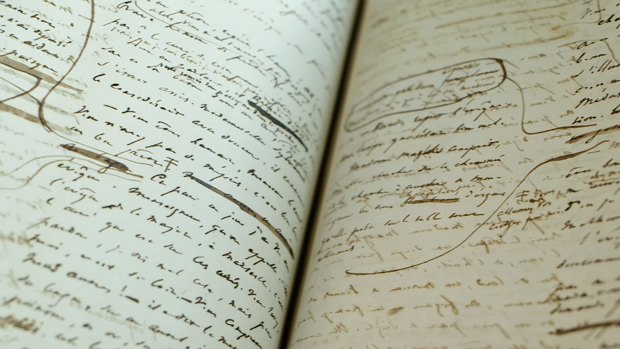By Jane Sullivan
The book is huge, like an old-fashioned ledger. Every page is covered with handwriting. But it’s only one part of the total manuscript of Les Miserables. No wonder, the monumental task of writing this novel took Victor Hugo 17 years. It’s like looking at a stone in a pyramid.
It sits under glass in the State Library of Victoria, open to ‘‘Part One: Fantine: Book Six: Javert: Chapter II: How Jean can turn into a Champ.’’ The scene is a conversation between Jean Valjean, the redeemed convict, now at liberty under a new name, and his nemesis, Inspector Javert, who announces they have caught the convict Valjean.

Magical: The manuscript of Les Miserables, by Victor Hugo, is full of the author's alterations and ideas.
Here’s a sudden terrible dilemma for the real Valjean: should he reveal his identity, or allow an innocent man to go to the gallows? The author goes about the scene with his characteristic care, writing the story in the right-hand margin of the page, making corrections in the left-hand margin.
Even if you know your French, it’s not an easy read. There are many corrections and many crossings-out, in broad lines that look like brush strokes. At one point there’s something that appears to be a little doodle. The final version is outlined in red ink.
The exhibition Les Miserables: From Page to Stage scored a great coup by persuading the Bibliotheque Nationale de France to allow Hugo’s manuscript to travel outside France for the first time. It’s among many fascinating treasures that reveal to us the intensely political and popular giant behind today’s hit musical.
I like the frenetic feel of the quick sketches Hugo made of his characters, or the scraps of paper he found to scribble an idea or a scene. He covered every inch of the paper, then scored it through when he’d finally transcribed it to his manuscript.
We can also use an interactive device to find out how other pages of the manuscript were changed. It’s the nearest we can ever get to climbing inside the author’s mind.
There is something almost alchemical about the handwritten manuscripts of great books, and while nothing quite beats a sight of the real thing, we don’t always have to have them hauled out of museums and brought halfway round the world: thanks to modern technology, some are visible in other ways.
The manuscript of Charles Dickens’s Great Expectations was recently published in facsimile, and you wonder how he was able to read such a mess of inky marks. His scrawl slopes downwards, he’s scored through huge numbers of lines. If he was a schoolboy he’d get a black mark. Heaven knows how his typesetter deciphered it.
F. Scott Fitzgerald’s various draft manuscripts of The Great Gatsby are much easier to read, in the digitised versions produced by Princeton University and available online at its digital library.
And Emily Temple at Flavorwire has collected an online gallery of handwritten pages from various authors that are intriguing to compare, though there’s not usually information as to whether these are early drafts or already worked-on clean copies.
Gustave Flaubert’s Madame Bovary page is wild. The writing slopes upward, with scribbles in the margin and frequent crossings-out in the text. But the most worked-upon and illegible page, covered in crazy arrows, is from Vladimir Nabokov’s Invitation to a Beheading. I don’t know what he was up to, as it’s all in Russian, but it was intense.
I like the frenetic feel of the quick sketches Hugo made of his characters.
Now most corrections are done on the computer, life is a lot easier for writers. But perhaps we readers have lost something. It’s no longer possible to feel that heat of composition blazing off the page.